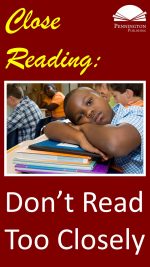Independent Close Reading
I hesitate to criticize a good thing too harshly. We teachers tend all-too-often to abandon something that works for the new latest and greatest educational fad. This is certainly not my intention in criticizing aspects of the close reading strategy and suggesting revisions.
By way of reminder, close reading is a multi-level strategy to encourage readers to access meaning independently. Close reading advocates achieve this end by avoiding pre-reading strategies and using text-dependent questions to complete three reading tasks: during the first read, students focus on gleaning key ideas and details. In the second read, students focus on how the author has designed the text (craft and structure). In the third reading, students focus on the integration of knowledge and ideas, such as preparing to use the text in discussion, writing, and comparisons with other texts. Close reading is certainly nothing new and is only one means of helping students become more analytical readers, as I describe in a related article., “Close Reading: Don’t Read Too Closely.”
Since the advent of the Common Core Standards and the concurrent re-popularization of the close reading strategy by the Common Core authors, teachers have been teaching more rigorous, expository text (a good thing). Teachers are training students to dig deeply into text and read for meaning (a great thing). Teachers have abandoned pure reader response, a.k.a. whole language, activities which focus more on what the reader brings to and gets out of the text rather than what the author has to say (a radical paradigm shift). Wahoo!
However, as noted U.C. Berkeley reading researcher, David Pearson, comments about close reading : “We need a mid-course correction, not a pendulum swing… but with BALANCE in mind… (making) sure that it applies to several purposes for reading (and will) encompass literal, interpretive, and critical reading tasks” (Pearson).
Mid-course Corrections: Two Proposals
1. Close reading advocates are wrong about avoiding pre-teaching. Cold reads in-them-of-themselves do not develop independent readers. Teachers do need to pre-teach (the “into step” of reading) and/or have students pre-research the topic (if an expository close reading) or the author, context and/or genre (if a narrative close reading), especially with rigorous reading-level close readings. Having students access prior knowledge and gap-filling with our diverse learners via pre-teaching strategies (Marzano) improves comprehension and does not turn our students into teacher-dependent learners. Indeed, comprehension builds upon comprehension and enables students to independently access text. The reading research of the last sixty years is quite extensive regarding the positive impact of pre-reading strategies.
2. Close reading advocates over-emphasize the value of text-dependent questions. Now, I certainly agree that we don’t want to return to non-dependent text questions, such as “How does this make you feel?” “How does this apply to your life?” How does your life apply to what the author says?” Aargh! My point is that text-dependent questions foster teacher-dependence during the reading process itself. The goal of reading becomes answering the teacher’s questions. Now I’m not saying that we shouldn’t add insight and provoke relevant reader response with some of our teacher questions. However, if we are to create truly independent readers, we need students to develop self-generated question strategies. This interactive talking to the text has a solid research base and is key to improving reading comprehension.
So let’s tweak a good thing (close reading) and make it a better reading strategy that truly helps teachers develop independent readers. Let’s use Independent Close Reading to accomplish that end. Interested in resources to help you do just that? Check out the Close Reading Expository Worksheet FREE resource download HERE and the Close Reading Narrative Worksheet FREE resource download HERE.
*****

The Science of Reading Intervention Program
The Science of Reading Intervention Program: Word Recognition includes explicit, scripted, sounds to print instruction and practice with the 5 Daily Google Slide Activities every grades 4-adult reading intervention student needs: 1. Phonemic Awareness and Morphology 2. Blending, Segmenting, and Spelling 3. Sounds and Spellings (including handwriting) 4. Heart Words Practice 5. Sam and Friends Phonics Books (decodables). Plus, digital and printable sound wall cards, speech articulation songs, sounds to print games, and morphology walls. Print versions are available for all activities. First Half of the Year Program (55 minutes-per-day, 18 weeks)
The Science of Reading Intervention Program: Language Comprehension resources are designed for students who have completed the word recognition program or have demonstrated basic mastery of the alphabetic code and can read with some degree of fluency. The program features the 5 Weekly Language Comprehension Activities: 1. Background Knowledge Mentor Texts 2. Academic Language, Greek and Latin Morphology, Figures of Speech, Connotations, Multiple Meaning Words 3. Syntax in Reading 4. Reading Comprehension Strategies 5. Literacy Knowledge (Narrative and Expository). Second Half of the Year Program (30 minutes-per-day, 18 weeks)
The Science of Reading Intervention Program: Assessment-based Instruction provides diagnostically-based “second chance” instructional resources. The program includes 13 comprehensive assessments and matching instructional resources to fill in the yet-to-be-mastered gaps in phonemic awareness, alphabetic awareness, phonics, fluency (with YouTube modeled readings), Heart Words and Phonics Games, spelling patterns, grammar, usage, and mechanics, syllabication and morphology, executive function shills. Second Half of the Year Program (25 minutes-per-day, 18 weeks)
The Science of Reading Intervention Program BUNDLE includes all 3 program components for the comprehensive, state-of-the-art (and science) grades 4-adult full-year program. Scripted, easy-to-teach, no prep, no need for time-consuming (albeit valuable) LETRS training or O-G certification… Learn as you teach and get results NOW for your students. Print to speech with plenty of speech to print instructional components.
Click the SCIENCE OF READING INTERVENTION PROGRAM RESOURCES for detailed program description, sample lessons, and video overviews. Click the links to get these ready-to-use resources, developed by a teacher (Mark Pennington, MA reading specialist) for teachers and their students.
Get the SCRIP Comprehension Cues FREE Resource:
![]()
Get the Diagnostic ELA and Reading Assessments FREE Resource:![]()
*****
